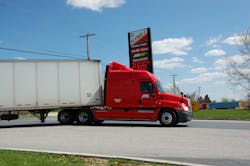NIOSH newsletter revisits truck driver survey data
A new newsletter begun by the National Institute for Occupational Safety and Health (NIOSH) at the end of last year – dubbed Behind the Wheel at Work – seeks to illuminate industry issues that can affect truck driver safety, especially for long-haul operators.
In particular, NIOSH’s Center for Motor Vehicle Safety used the first issue of this newsletter to revisit findings from personal interviews conducted in 2010 with 1,265 long haul truck drivers – which the agency said comprises the “majority” of the 1.7 million people employed as heavy- and tractor-trailer truck drivers in the U.S. – at 32 truck stops across the U.S.
According to that survey:
- On average, long-haul truck drivers work 60 hours per week and drive more than 107,000 miles per year.
- More than one in 3 had at least one truck crash at work during their career.
- 73% of long-haul truck drivers perceived their delivery deadlines as “unrealistically tight,” which may be an incentive for risky driving behaviors such as speeding (4.5% often and 26% sometimes), hours-of-service violations (10% often and 27% sometimes), and continuing to drive despite fatigue, bad weather, or heavy traffic (24% often and 47% sometimes).
- 14% of long haul truck drivers said they sometimes or never wore a seatbelt.
- 38% reported receiving inadequate training at the beginning of their careers.
- 5% of long haul truck drivers reported at least one non-crash injury involving days away from work in the previous 12 months; among company drivers, 68% of these non-crash injuries involving days away from work were not reported to employers.
